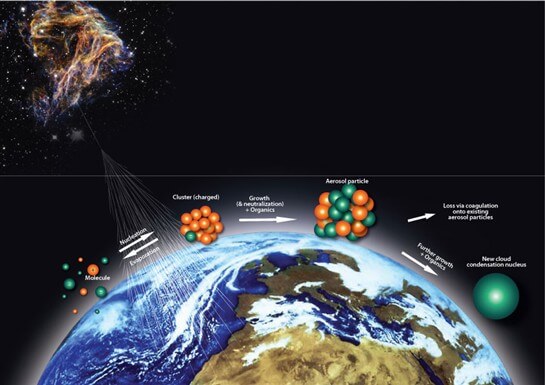However, the mechanism by which cosmic rays accelerate cloud formation only explains what happens in the upper atmosphere. In the lower atmosphere, traces of additional substances are required, most likely the product of human pollution

The findings of the CLOUD project, conducted in Sern (the world's largest particle research center located on the Switzerland-France border, west of the city of Geneva), show that vapor trails, which until now have been considered responsible for the formation of aerosols in the lower atmosphere, can only explain a small part of the observed atmospheric aerosol output. The findings also show that a process of ionization originating from cosmic rays significantly increases the formation of the aerosol. Accurate measurements such as these are important to gain a quantitative understanding of cloud formation, and they could contribute to a better assessment of cloud effects in climate models.
The CLOUD (Cosmic Leaving Outdoor Droplets) project is an experiment using a cloud chamber to examine the possible connection between cosmic rays in the galaxy and the formation of clouds. This is the first time that a high-energy accelerator, located in the Axis Particle Accelerator, is used to examine atmospheric and climate sciences (Wikipedia).
In an article published in the scientific journal Nature, the CLOUD project describes its first findings. This project aims to examine the effect of cosmic rays (high-energy rays originating from outside the earth) on the formation of atmospheric aerosols - tiny liquid or solid particles dispersed in the atmosphere - under controlled laboratory conditions. Atmospheric aerosols are thought to be responsible for a significant part of the nuclei of the formation of cloud droplets. Understanding the formation process of the aerosols is, therefore, important for understanding the climate.
"These new findings from the CLOUD project are significant since we were able to obtain a number of initial observations regarding very important atmospheric processes," said project spokesperson Jasper Kirkby. "We discovered that cosmic rays significantly increase the formation of aerosol particles in the middle atmosphere and above it. These aerosols could eventually develop into cloud formation nuclei. At the same time, we found that the vapors previously thought to be responsible for the entire formation of aerosols in the lower atmosphere can only explain a small part of the observations - even in view of the amplification of cosmic rays."
Atmospheric aerosols play an important role in climate. Aerosols reflect the sun's rays and produce cloud droplets. More aerosols, therefore, will cause the clouds to lighten and extend their duration. Current estimates indicate that about half of the cloud droplets begin with the accumulation of molecules that are present in the atmosphere in extremely small amounts only. Some of these primary clusters develop and reach sizes sufficient to become the nuclei of the formation of cloud droplets.
Traces of sulfuric acid and ammonia vapors are considered to be significant to this process, and are involved in all atmospheric models, however the mechanism and rate by which they form aggregates together with water molecules has been limitedly understood to date.
The findings of the project showed that several kilometers up in the atmosphere, sulfuric acid vapor and water vapor can quickly produce clusters, and that cosmic rays indeed increase this rate of formation tenfold or even more. However, in the lower layer of the atmosphere, at a height of one kilometer above the earth's surface, the findings of the project show that additional vapors, of ammonia for example, are required for this purpose. The observations show that sulfuric acid vapors, water and ammonia alone - even together with the amplification of magic rays - are not sufficient to explain the atmospheric observations of aerosol formation. Therefore, additional vapors must be involved in this process, and finding their nature should be the next step in the project's experiments.
"It was a big surprise to discover that the formation of aerosols in the lower atmosphere is not caused by sulfuric acid vapors, water and ammonia only," said the spokesperson of the project. "Now it is essential to find out what the additional vapors involved in the process are, whether they are natural or man-made, and how they affect the clouds. This will be our next mission.”
The CLOUD project includes an advanced experimental chamber where atmospheric conditions can be simulated while obtaining a high degree of control and precision, including the concentration of vapor traces that encourage the formation of aerosols. A particle beam from the Axis particle accelerator provides an artificial and tunable source of cosmic rays.
The news about the study

4 תגובות
It means magical rays sent by the magician up there.
What is cosmic?
Thanks
Cosmic rays also cause lightning
Interesting, thanks for the information.